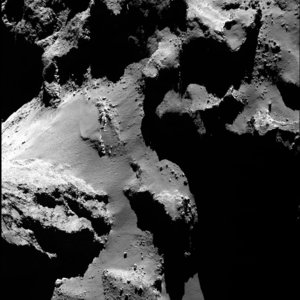

Comet changes: moving boulder in Khonsu
A 30 m-wide, 12 800 tonne boulder, was found to have moved 140 m in the Khonsu region of Comet 67P/Churyumov–Gerasimenko in the lead up to perihelion in August 2015, when the comet’s activity was at its highest. In both images, an arrow points to the boulder; in the right-hand image, the dotted circle outlines the original location of the boulder for reference.
The movement could have been triggered in one of two ways: either the material on which it was sitting eroded away, allowing it to roll downslope, or a sufficiently forceful outburst could have directly lifted it to the new location. Indeed, several outburst events were detected close to the original position of the boulder during perihelion.
The images were taken by Rosetta’s OSIRIS camera on 2 May 2015 (left) and 7 February 2016 (right), with resolutions of 2.3 m/pixel and 0.8 m/pixel, respectively.





